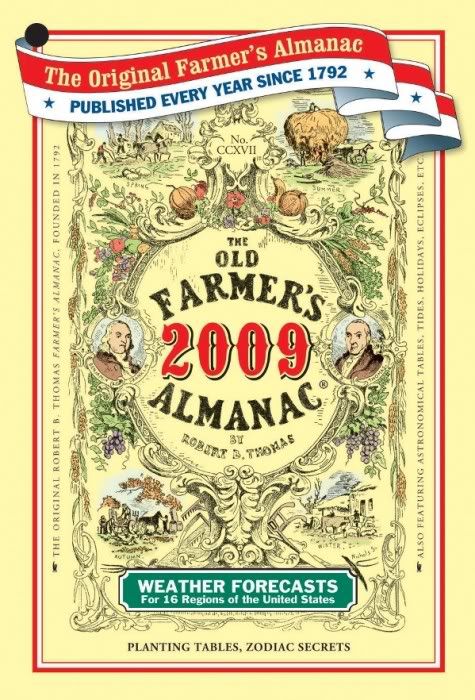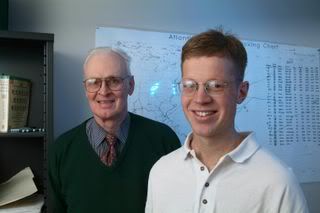Just in case you haven't noticed, I've not been in the blogging mood lately....and I'm still not. :-)
With permission, I am re-posting a blog post today by Brian Barnes of STORMCHASE.com. Brian's post triggered memories I have of a farm field that would get rain at one end of the field but not the other, of a line between home and Fort Wayne where the winter weather would change from one side of the line to the other and all the old weather sayings that were, for the most part, true. I've always wondered about the accuracy and forecasting methods of The Old Farmers Almanac. Thanks Brian for allowing me to re-post your blog post.
Old Farmers Almanac
Sep 11, 20092009 Edition of The Old Farmer's Almanac
While at the bookstore that bares my family name the other day I picked up an interesting book that has been published annually in September since 1792 – The Old Farmer’s Almanac (OFA).
I haven’t looked at one these books since my childhood when I would spend time during the summers visiting my grandparents in Kansas. My grandfather was a Kansas farmer and like most, he used OFA for its planting charts, weather predications and there were articles in it that my grandmother would read as well such as recipes and trending items in home décor.
Like many farmers, my grandfather had a lot of weather forecasting techniques that he developed himself, based on his own observations from many years of living in the Central Plains where the weather can go from a peaceful sunny day to a violent nightmare in a matter of minutes.
I remember many times when he would see common houseflies clinging to the outside of the screen door as if they were desperately trying to get into the house and he would proudly announce – “It’s going to rain.” Sure enough, usually within the hour the cumulus clouds would start building and rain it did.
Over the years of storm chasing, I have had many opportunities to speak with like-minded rural people of the Great Plains who owned farms. I literally can’t count the number of times when I would be parked on some lonely country road while watching a storm and some old farmer would pull up next to me in his rusty pick-up truck and just ask a simple question such as – “Well, is it going to get bad?”
Such questions would usually spark a conversation about how storms always come over a certain area in the farmer’s view, and why he ended up with so many bushels of crop from that field, while another nearby field would never get rain and yield fewer crops. The bottom line is – if you ever really want to know about a location’s weather, just ask a farmer. So, it would only make sense that OFA would have a lot of great information – after all it’s the longest running periodical publication in America’s history.
I flipped through its pages and landed upon an article called Hurricanes: Questions and Answers. Could this book really hold all the answers to my questions about hurricanes? Doubtful – not even all the published papers in science journals could do that – but, it was worth a read so in the words of my grandfather, “I gave it a gander.”
In a nutshell, OFA predicts that 2010 will be a wild and active hurricane season in the Atlantic Basin. But, forecasting is all about validating your forecast – and since they’ve been at this for awhile I thought I would check on their most recent past long-range hurricane forecast for the 2009 season.
According to the 2009 OFA, their readers should watch out for an active Florida season as well as a hurricane to hit the Gulf Coast and a late-August hurricane along the Atlantic Corridor.
Oops. That was a bit off I’d say. You know the people at OFA were paying very close attention to Hurricane Bill just off the Atlantic Coast in mid-August. But, the 2009 season thus far has been one of the quietest tropical seasons I’ve seen in a very long time. Well, it seems that way anyway since we’ve not seen much action in the United States directly – but in fairness, it’s been just slightly below average in terms of named tropical systems and hurricanes.
Dr. William Gray & Dr. Dr. Phillip Klotzbach, CSU
And, that’s exactly what Dr. Gray and his team of hurricane forecasts crunching nerds at Colorado State University had predicated (btw, I meant that as a compliment).
The CSU team had predicted that 2009 would include 11 name storms, five hurricanes of which two would be major (Category 3, or above) would happen in the 2009 season. Their forecast specifically stated the season would be slightly below average in terms of named systems and hurricanes.
Granted there are still about 45 days left in this season – but here is what we’ve had so far: six named storms, two hurricanes, and both of those became major hurricanes having at one time reached the threshold of a Category 3 storm on the Saffir-Simpson Intensity Scale.
I’m pretty familiar with the forecasting techniques used by the CSU team, I was left wondering about how OFA put their forecast together. It’s interesting to also point out that OFA publishes their forecast with the time that the periodical itself is published – September. While the CSU’s team forecast generally come out in December and then are modified in April and in June, giving them a bit of advantage as issuance occurs closer to the start of the season.
OFA claims their “original formula” was created by the periodicals founder, Robert B. Thomas in the 1790s who believed that the Earth’s weather was heavily influenced by sun spots and that Thomas’ original notes were locked down in a “Black Box” in the company’s office at Dublin, NH. That sounds pretty sleuth to me. Nothing like the old marketing tactic of protecting the original formula – just ask Jay Bush about his baked beans!
However, over the years they have refined this original formula so that it’s up-to-date with modern scientific thinking – sort of. The newer method is based on solar activity, climatology and meteorology.
Here is exactly what OFA says – “We employ three scientific disciplines to make our long-range predictions: solar science, the study of sunspots and other solar activity; climatology, the study of prevailing weather patterns; and meteorology, the study of the atmosphere. We predict weather trends and events by comparing solar patterns and historical weather conditions with current solar activity.”
Altogether, that doesn’t sound half bad, but from a scientific viewpoint and techie gear-head, I’m not sure that the method compares to one that crunches zillions of weather variables on the world’s largest computer, which is more or less the method used at CSU. But even with the world’s most powerful computer at their fingertips, even CSU’s predications are only validating about 50 percent of the time.
Something else I find a bit interesting with OFA’s original formula is solar science in itself as it existed in 1792. While sunspots were first sighted centuries ago and dates back to 28 BC in ancient China, it wasn’t until 1848 that Rudolf Wolf began making systematic observations and created the “Wolf Number,” which is an expression of individual spots and spot groupings.
Also in that year, Joseph Henry was able to project an image of the Sun onto a screen and determine that sun spots were actually cooler than the rest of the Sun. So, until the mid-1800s, it was very difficult to observe and monitor sun spot activity on a continuing basis.
There is no mention from OFA that I could find in reference to Robert B. Thomas study of solar activity, or if he had a solar telescope that the rest of the world didn’t know about – or if such a solar telescope, or even a prism was inside the locked down “Black Box” that is protecting the original forecasting formula.
If comparing OFA’s forecast to CSU’s forecast in 2009 – I’d say it’s a bit of a tossup. While Dr. Gray’s team had forecasted a season that was less than average, the OFA’s forecast implied a busy season. That said, this season has been even quieter than Dr. Gray’s team had predicated (thus far, remember it’s still not over yet) – so both were wrong.
And, as far as OFA’s forecast for a hurricane to hit the Gulf Coast during August, it didn’t happen – And while, there was Hurricane Bill along the Atlantic Corridor, he stayed off-shore as a high pressure ridge pushed him to the east. Had the Bermuda High decided to move a bit west, it could have been a different story – and they (OFA) would have been able to claim success. But, since forecasting is about validation – their forecast didn’t completely validate.
OFA claims their forecast are based on solar activity such as sun spots.
And, it might sound as if I am being pretty hard and critical of OFA and the fact is – I am. While I enjoy a great read and fondly recall enjoying reading through OFA during my childhood summers while visiting my grandparents – it’s also a matter that the weather affects all our lives on a daily basis and such things as badly issued seasonal forecast affect us more than we might realize.
For example, it’s not a known secret that the insurance industry uses Dr. Gray’s hurricane forecast to try and mitigate and leverage their hurricane cost, as well as possible damage by in-land flooding. Florida’s insurance industry is in shambles (Florida home owners know exactly what I’m talking about).
To my knowledge no insurance company is basing any of their premiums upon the forecast predications published by OFA, since OFA isn’t a well-respected house of science (but they are respected in the publishing industry). But, it is the insurance industry after all and I trust them about as far as I can throw them (another borrowed one-liner used well by my grandfather). Badly issued forecast, while sometimes “fun,” could have a hard-impact on people – in fact, it could have a harder financial impact than if a storm actually did hit their home.
My harsh criticism wouldn’t come if I could find a disclaimer in the book that specifically mentioned that their forecast was not based on the latest available scientific knowledge or state-of-the-art technology, but in fact I find just the opposite with this – “Over the years, we have refined and enhanced that (original 1792) formula with state-of-the-art technology and modern scientific calculations.”
To me, that implies that OFA wants to be taken very seriously as a source of scientific forecasting.
The Gabriel Foundation CALIFORNIA FRIENDS - PLEASE REPOST!!! WILDLIFE WAYSTATION NEEDS HELP EVACUATING ANIMALS!!! Need flatbed trucks NOW!!! 14831 Little Tujunga Canyon Rd Sylmar, CA 91342 (818) 899-5021
I had my followup appointment with my sleep disorder doctor yesterday from my sleep study. I didn't realize until yesterday that he was investigating my Pulmonary Hypertension I was diagnosed with a few months ago. He is also a pulmonologist. He had gotten the info from my catheterization from my cardiologist. It ruled out causes but didn't determine a cause. One of the possible causes is sleep apnea. When I had my sleep study it showed I needed the pressure of my CPAP machine adjusted. Yesterday I had a test of lung function and capacity and it was good, ruled out as a PH cause. Now I need to get a chest xray. If it is good he said that rules out everything and leaves the sleep apnea as the cause.
Maybe I should quit complaining about the length of time I sit from appointment time until I actual see him!




